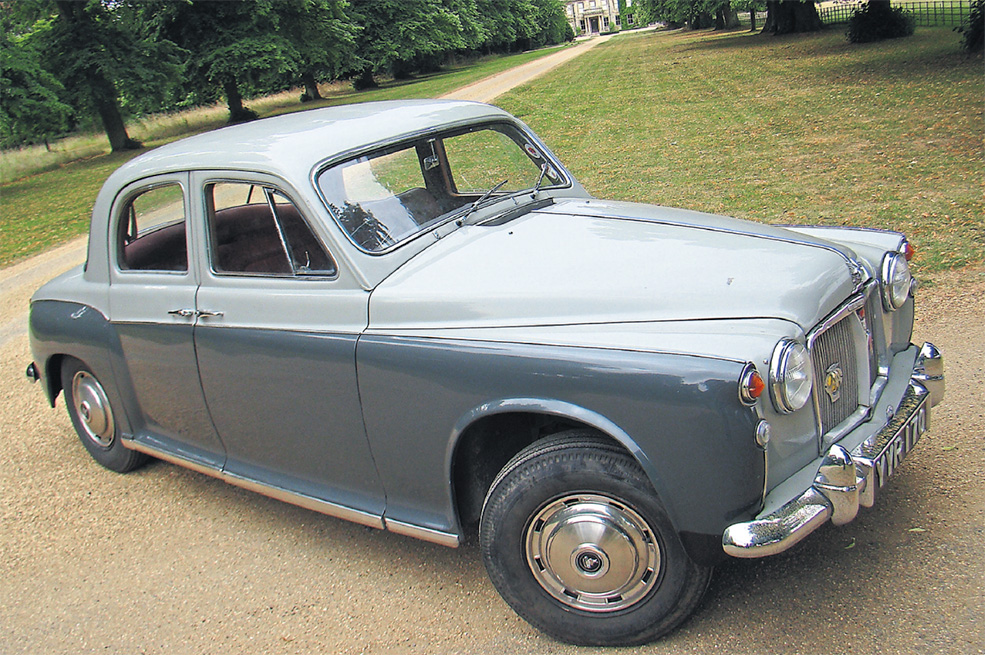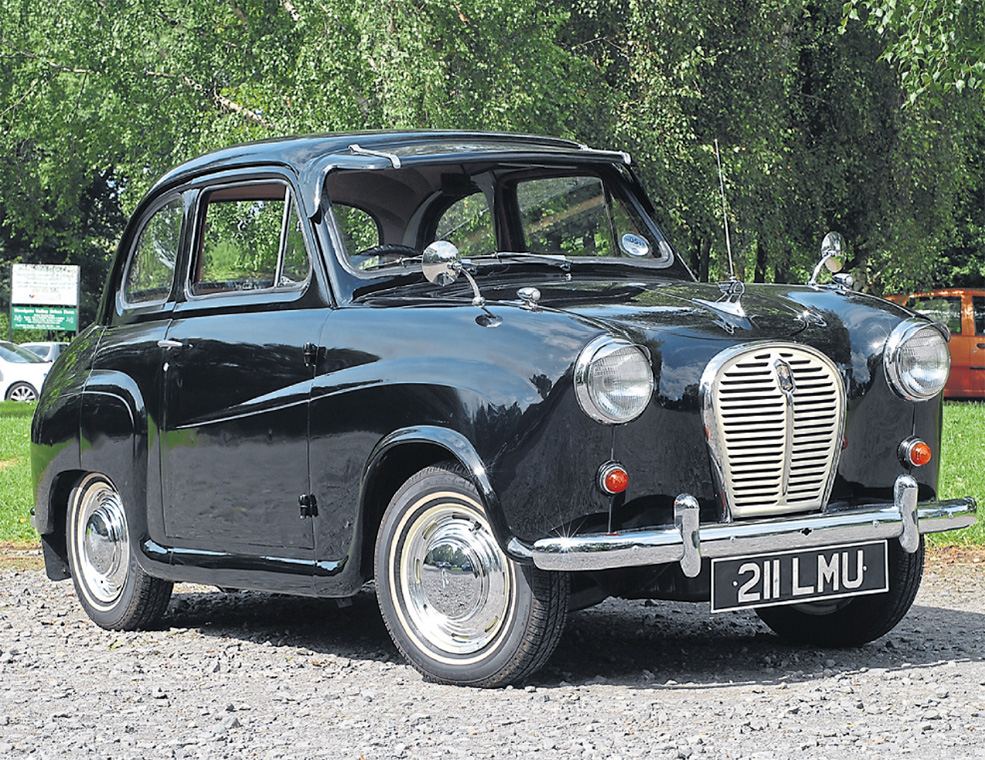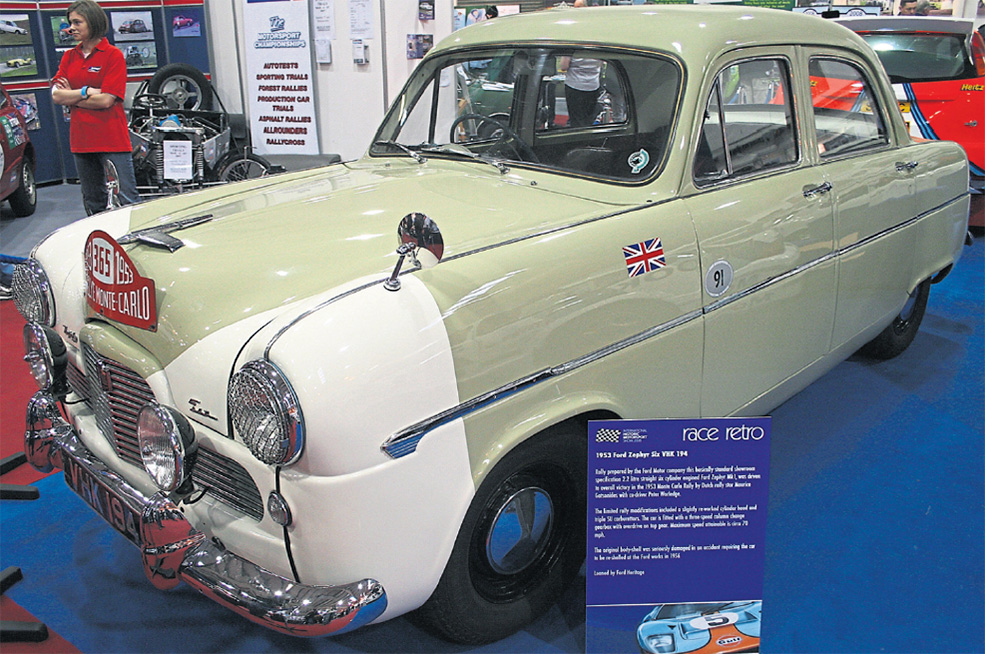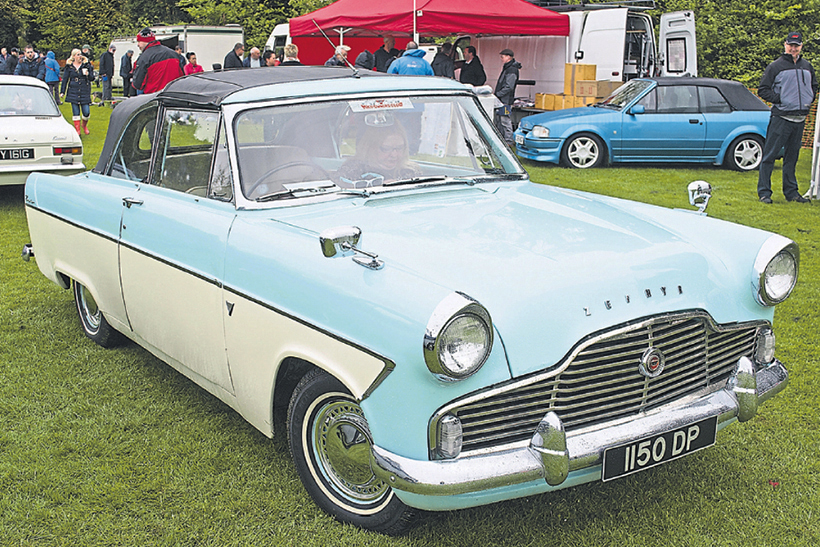For now any car that is built before 1960 is exempt from the annual MoT check. So which of these old-timers would be the most practical for daily use
If a driver from the Fifties was transported to the roads of 2017 behind the wheel of a brand new mid-range hatchback they might be slightly disappointed that they were not piloting a nuclear-powered flying machine between the towering spires of some Fritz Lang-style cityscape.
But while the broad strokes haven’t changed, the details have altered almost beyond recognition. Our driver from the age of Sir Anthony Eden, Hancock’s Half Hour and the tail-end of petrol rationing may not get the flying car they had been promised in the pages of The Eagle but even the writers of Dan Dare didn’t come up with satellite navigation, automatic cruise control, self-parking systems and all the other systems that the modern machine has.
And at a fundamental level the modern car is more refined, more powerful, more reliable, more complicated, more comfortable, less needy and far more capable than anyone in 1955 had the slightest inkling of.
Given that, it can be easy to think that a pre-1960 car (one that is, at the moment, specifically MoT-exempt due to its Historic status) must be a museum piece just above the level of going to work on a penny farthing. But that is not the case. There are plenty of cars approaching their 70th birthday which could still be pressed into regular use.
To lay out our terms, what we’re looking at here is a selection of MoT-exempt cars that could be used for ordinary everyday duties without undue discomfort to the car or the driver. Of course every car has been designed for everyday use, and someone out there is about to write in and say they still go shopping in their great-great grand father’s De Dion-Bouton Model Q.
We’re not saying it can’t be done! But these are cars that stand a good chance of working reliably and constantly without too much maintenance and which have good enough parts support that if a problem did arise you would be back in business quickly.
We are also thinking mostly of daily use during the summer months as that’s the sort of time when it’s actually quite pleasant to roll around in a classic. Scraping ice off the inside of your windscreen and only having enough amps in your battery to have either the wipers or the headlamps (but not both) is not what we had in mind!

ROVER P4
As its ‘Aunty’ nickname suggests, the P4 has picked up a reputation as a staid, solid and traditional sort of car. It’s certainly not one that would be ruffled by regular use, even over long distances. But it was not the paragon of conservatism that it came to be. On its introduction in 1949 the P4, then available only as the Rover 75 with a 2.1-litre straight-six engine, trod a lot of new ground. Rover’s hard-won reputation for engineering quality was in the bag but the outgoing P3 was a conventional, almost willfully old fashioned design. The P4 had a full-width ‘three box’ shape body with integrated wings and inset headlamps, plus a central ‘Cyclops eye’ spot lamp. Inside was wood and leather, sure, but it was all straight lines and flat panels, giving the interior a strangely sparse yet comfortable air. The wheels were set wide apart and seemingly in the extreme corners. That smooth six-pot engine had Rover’s new inlet-over-exhaust lay-out, providing efficient and powerful combustion even on nasty ‘pool’ petrol and boasted twin carburettors, an aluminium cylinder head and chrome-lined cylinder bores. This was a car designed to go places, and for a long time.
Of course that original ‘Cyclops’ 75 spawned a whole range of solid, dependable and comfortable Rovers. Some of the more outlandish styling details of the original were toned down but otherwise the range was subject to relentless improvement. Smaller and larger engines were offered with four (the two-litre Rover 60) and six (the 2.6-litre Rover 90) cylinders. At the same time came the switch to a floor-mounted gear lever on a beautifully-designed ball-and socket mounting so it could be adjusted for height and reach, representing as much engineering work as an entire Bond Minicar. In 1954 came David Bache’s masterful facelift which somehow made the P4 look sleeker while remaining unmistakeably upright, plus the addition of a large boot which balanced up the proportions. New engine variants with new model names came and went but the definitive P4s were the new 2.6-litre models introduced in 1959 with a sevenbearing crankshaft and front disc brakes. The first of the new breed, the Rover 100, just squeaks into the MoT exemption zone, being introduced in the autumn of 1959, although the P4 itself would live until 1963.
Through it all, the P4 held its reputation for supreme quality – its status as ‘the middle class Rolls-Royce’ was very apt. These cars still have huge integrity and can handle anything the modern world throws at them, from steep country lanes to motorways. And they do it with an air of deep-seated refinement and ease that few others can muster. ‘Aunty Rovers’ have survived well and parts, especially for the later 2.6-litre models, are easily sourced, as is knowledge and expertise. However, despite their justified reputation, P4s can be quite maintenance intensive with lots of items needing regular lubrication and adjustment, plus running one needs coming to understand the inner workings of the rather idosyncratic IOE engine.
Price: Rover P4s are excellent value for money at the moment. A shining example of a 90 or 100 would be £15,000 while a perfectly decent one would fetch £10,000, which would also secure you a very good example of a four-cylinder car. The early ‘Cyclops’ 75s are real collectors items and are more valuable.
Pros:
• Supremely comfortable
• Excellent mechanical quality
• Reliable and easy to fix
• Wide-ranging parts support
Cons:
• Even the four-cylinder ones are thirsty
• Can be unwieldy to drive
• Sluggish performance for most variants
• A large amount of running maintenance
Our choice: A post-1954 facelift P4 90. If you can find a pre-1960 100 model, even better.

AUSTIN A35
The A35 was an economy car designed to bring motoring to the masses, so everyday practicality and easy ownership were baked into the recipe from the start. However, we’d caution against putting too many miles on the original ‘New Seven’, the A30. The original 803cc A Series engine, mustering all of 28 horsepower, really doesn’t cut it in the flow of modern traffic and if you suffer any problems relating to the original ‘bent wire’ crankshaft or its bearings you’ll find yourself struggling to find parts, plus some other unobtainable sundry bits specific to the 803cc models.
But the improved A35, launched in 1956, is a much stronger prospect – faster, stronger and more efficient. Today it has almost total parts support, provided you don’t end up having to source new front wings, and A35s don’t rust so badly that a summer’s daily use will see them eaten away with rot! The little Austin won its way into the hearts of budget-conscious motorists on the back of its robust and simple running gear, able to whizz along near its top speed of just over 70mph for hours at a time while also being able to sip fuel at 40 miles per gallon if driven more sedately.
These cars handle nicely in standard form although the hydro-mechanical brakes can require a certain amount of ‘re-learning’ some dusty driving habits such as anticipation and engine braking (maybe via double de-clutching). But otherwise an A35 is not at all demanding to drive, with good road holding and excellent grip at the front wheels thanks to its independent suspension and fast, pointy steering, although the steering box can feel a bit loose on first acquaintance. And don’t forget the existence of the Countryman estate model if the cabin of the saloon model feels a bit pokey or you need to factor load-carrying into your daily driving.
Another point in the A35’s favour is that you can adapt it and improve it to make what is already a fundamentally good car even better. It may not be entirely in the spirit of our exercise, but there is a lot you can do to make an A35 a more practical daily driver without removing either its cheeky character or its MoT-exempt status. Tuning work on the 948cc engine, or fitting a larger A Series unit altogether and hydraulic brakes, perhaps with front discs courtesy of an MG Midget, will make the Austin much more modern to drive, while modern accoutrements such as radial tyres, an alternator, electronic ignition, a pointsless fuel pump, a radio (perhaps one of those digital ones that tucks discretely under the dashboard?) and halogen headlamps can both make journeys more pleasant and further improve on the already good chances that when you go out to your A35 in the morning it will be willing and ready for action.
Price: Scruffy A35s can be bought for £2000 while the best examples go for around £8000 in four-door guise, with rarer (but more basic) two-doors fetching slightly more on average. Perfectly good cars can be yours for £4000. Countryman models are rare and can go for more than £10,000 while more common conversions from vans are worth less.
Pros:
• Easy to drive
• Everything is available
• Simple to work on
• Scope for modifying
Cons:
• Cramped cabin
• Basic comfort levels
• Poor brakes
• Low performance
Our choice: A four-door model with its original 948cc engine but with some light tuning and hydraulic brakes.

RILEY ONE-POINT-FIVE
Inevitably the Morris Minor crossed our minds when we compiled this list – it’s such a good all-rounder that it crops up on almost any list of five classics for any purpose you care to think up. But if you were to use a Minor every day, especially one made before 1960, then some extra performance and comfort wouldn’t go unappreciated. Fortunately there is such a thing available in the form of the Riley One-Point-Five.
In the mid-’Fifties BMC began looking at ways of improving the Minor. The styling was already becoming old fashioned and, from the export markets especially, there was a perpetual demand for more power. So the stylists got to work producing a new ‘pontoon’ body with looks very similar to the existing Series 2 Oxford while the engineers set about fitting the B Series, then in 1.5-litre form. The ‘new Minor’ only made it into production in Australia as the Morris Major. However BMC was never an organisation to pass up on a chance to do some badge-engineering so it was decided that the market would take the restyled, bigger-engined Minor if it was made suitably upmarket.
This led to the arrival of a new pair of twins in 1957, the Riley One- Point-Five and the Wolseley 1500. They were largely identical, differing in their badging, grille shape and a few mechanical and interior details. As befitted Riley’s more sporting heritage the One-Point-Five had a second carburettor and larger valves, giving it 68 horsepower, and a tachometer set into the wooden dashboard. The Wolseley had a ‘two dial’ dash, lacking the tachometer and the standard single-carb engine of 50 horsepower. The sportier Riley also had Girling brakes, offering greater friction area over the Wolseley’s Lockheed parts. Although steeply priced at around £800, the One-Point-Five teamed the Minor’s superb roadholding, good ride quality and famously accurate steering with genuinely peppy performance (a top speed of 85mph) and a high degree of luxury courtesy of that polished walnut dash, two-tone leather upholstery and a fresh air heater.
But that shouldn’t detract from the fact that the One-Point-Five was an excellent car with genuine sporting abilities which proved itself in rallying and racing in its day at all levels from amateur club meetings to touring car racing to international rallies. Now it benefits from the great popularity of the cars with which it shares all its mechanical bits (Minor running gear and B Series-powered classics almost beyond count). Like the Minor, it is unchallenging to drive but it has more than enough poke to nip around modern traffic or not become a rolling road block in hilly areas. Comfortable seats, a good heater and a reliable and unstressed engine all make for a very dependable and charming machine.
Price: Rileys change hands for around £6000 for those in solid and pretty condition. Rougher or older-restored examples can be had for around £4000. The less powerful but much more common Wolseley tops out at £5000.
Pros:
• Spritely performance
• Excellent handling
• Very comfortable
• Familiar mechanicals
Cons:
• Rare, especially pre-1960
• Unique trim parts hard to find
• Body panels expensive and rare
• Prone to rust
Our choice: There is no choice when it comes to these – you have to have the Mk1 model ‘as is’!

Mk1/Mk2 FORD ZEPHYR
A ‘Fifties family favourite, known for its spacious cabin, robust running gear, strong performance and value for money sounds like an equally good bet as an MoT-exempt daily runner today.
Rarely has a car ever been quite so literally ‘all new’ as the new Ford Consul in 1951. It was a true monocoque car (although it retained a vestigal X-frame underneath) and was also the first in the world to use Ford’s newly-designed Macpherson strut front suspension. It had a new family of overhead-valve engines and fully hydraulic brakes. Stylistically, its blocky body with sheer sides and rounded corners was startlingly modern. Rivals may have had one or two of the Consul’s innovations but not all of them at once. A spacious cabin with seating for six and a famously snappy column-shift gearbox were also selling points.
Shortly after the Consul came the more upmarket Zephyr, with a longer wheelbase and a longer body to accomodate a 68 horsepower 2.2-litre six-cylinder engine. This was sufficient to urge the Ford onto a top speed of 80mph in a Britain without any motorways. The Zephyr, like the Consul, gained a reputation as a reliable, simple and practical machine that offered excellent value for money, even if the six-cylinder version was a trifle thirsty and the performance revealed that for all its modern suspension the car was dynamically pretty soggy.
In 1956, the Mk2 Zephyr was introduced as a major tweak of the original design. The fundamentals remained the same but it was greater in wheelbase, length and track. The weight distribution was made more neutral and the engine was increased in size to 2.6 litres. The exterior was completely restyled along the lines of the contemporary Ford Fairlane in America with wraparound screens, peaked headlamps, full-width grilles and bumpers and subdued tailfins. These glitzy, fast cars were immensely fashionable with younger motorists even if they couldn’t afford them and most Zephyrs ended up as the workhorse of middle class professional families. The attractive looks and sales success of the Consul, Zephyr and the range-topping Zodiac led to the trio becoming known as ‘The Three Graces’. In 1959, the looks were improved further by the roofline being lowered by just short of two inches and the rake of the screen being altered to match, with these becoming known as ‘Lowline’ models.
While rust and banger racing finished off the majority of early Zephyrs a long time ago, the survivors are just as useful as they were in the ‘Fifties. They have so much period flair that you can forgive the dynamic shortcomings (especially of the Mk1) and you soon just bounce along at the car’s natural pace, which is more than adequate for today’s roads and there is plenty in reserve.
Price: Zephyrs are desirable slices of ‘Fifties vintage chic now, especially the Mk2s with their dose of Americana. They change hands for £15,000 or so for the best cars, with roadworthy and practical ones going down to £10,000 or so. The Mk1s are rarer but lower value, fetching around £12,000 at the top end.
Pros:
• Stylish and spacious
• Reliable running gear
• Strong performance
• Modern design
Cons:
• Roly-poly handling
• Some parts hard to find
• Pretty heavy on fuel
• Expensive for what they are
Our choice: A ‘Highline’ Mk2 Zephyr, preferrably in two-tone blue-over-cream.

TRIUMPH TR3
We’ve majored on practicality with our other four choices but if we’re thinking of hypothetical daily use during a balmy summer then why not throw at least one soft-top into the mix. And what if you don’t want to potter around day after day in a sensible mid-market saloon? Enter the Triumph TR3.
The original TR2 had been something of an unexpected success but it had laid down a winning formula so Triumph settled into the chain of incremental improvements that would see the TR breed evolve over the years to come. As presented on its launch in 1955, the only real difference the TR3 had was a proper radiator grille and five more horsepower thanks to larger SU carburettors. The bodywork, cockpit, chassis, suspension, steering and brakes remained unchanged. After just under a year on sale, the first real change came when front disc brakes were fitted, making the TR3 the first British production car to have them. A full-width grille and slightly better interior fittings (including exterior door handles, a lockable boot and a fixed windscreen) came along with the TR3A of 1957, as did a free-flow cylinder head taking power output north of 100 horses for the first time. The last year of production, nearly all of which went to the USA, featured the 106-horsepower 2.1-litre engine from the incoming TR4 model.
What distinguished the TR3 was the sheer robustness of its running gear, and when you consider that its main competition was the MGA, which is by no means brittle, that is saying a lot. The TR engine’s humble origins in the ‘Little Grey Fergie’ tractor make it phenomenally strong with huge scope for tuning and the transmission and suspension is similarly rugged. The TR3 was also a quick car, with 50 per cent more power than its MG rival in standard tune and no real penalty in weight, for all its tractor-like mechanical heft.
The TR3 has the tightly-wound ride, heavy steering and rather fidgety back axle that is typical of so many classic British sports cars, which are enough to make taking the car by the scruff of the neck (usually requiring you to flex your right bicep over the low-cut cockpit door) an exercise of equal parts valour and skill. But the TR3 is also quite happy servicing as a roadster rather than a Le Mans-bred sports car. The engine is, if you’ll forgive the pun, tractable and with the wind in your hair, the flies in your teeth, the exhaust in your ears and the smell of summer in your nostrils it is still an enjoyable car to drive at five-tenths. The parts supply for anything that you’d need to keep a TR3 in daily service is brilliant and the commonality with later TR models mean that there is huge scope for improvements if you want, such as more powerful engines, better brakes and rack and pinion steering.
Price: TR3 prices vary quite widely depending on condition, originality and specification. Useable TR3As can be bought for around £18,000 but the really good ones are currently at the £22,000 mark or thereabouts. Rarer TR3 and TR3Bs fetch closer to £30,000. Upgrades can slightly increase the value if they are sympathetic and reversible.
Pros:
• A true sports car
• Strong and simple
• Excellent parts supply
• Easy to upgrade if needed
Cons:
• Choppy ride and cramped cockpit
• Poor weather protection
• Not much to deter thieves
• Can be tiring on longer journeys
Our choice: A TR3A in red with a tan interior, perhaps with a TR4-spec engine and brakes.
WHAT ABOUT A WILD CARD?
For our off-the-wall choice we are not going to suggest one specific car, but a whole category. Why not try an American car? Designed to work across greater distances and at greater speeds than any European car, American cars of the Fifties have, almost without exception, simple and strong running gear plus a comfortable ride, good interior appointments and more than enough performance. The parts supply can be excellent if you go for a common model (such as Buick Special, a Chevrolet Bel Air or a 1955 Ford) and are easy to order over the internet.
CONCLUSION
Going for practicality and reliability means that the field is somewhat ‘samey’ – all pretty conventional saloons. The exception, of course, is the TR3 so if you want a sports car or a convertible then it must win by default. If wrestling with side screens in the event of a downpour or having shopping rolling around the cockpit doesn’t sound ideal, then we must go for a tin-top. The Riley is probably the best sweet spot of practicality, performance, reliability and spares support in its standard form but in reality you will have to search very hard to find one of the 40-odd pre-1960 One-Point-Fives left on the roads for sale and having done so would you really want to use it in the daily grind? The Austin A35 would be one of the easiest to keep roadworthy, especially if you are going to forgo the annual MoT check and become your own assessor, but they are cramped and slow in standard form, even if the scope for modifying is there. The little Austin has a lot of appeal if your daily driving is to be mostly rural or in a city centre, but on A-roads or motorways? We’d rather not. So we’re left with two big six-cylinder saloons, the Rover or the Ford. This comes down to personal taste – the brash American or the suave Briton – but considering the fact that the Ford is now more expensive to buy and the Rover is significantly better-engineered, my personal recommendation would be for ‘Aunty’.






